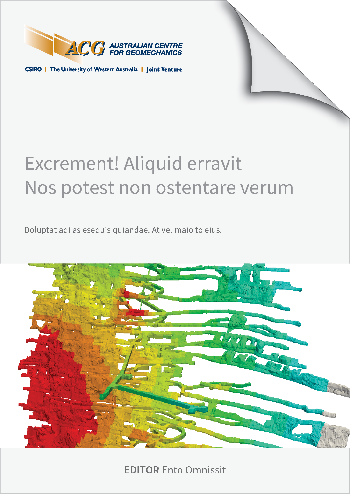Progress towards volumetric monitoring of cave mine propagation with novel quantum absolute gravity methods

|
Authors: McCalman, LR; Wigley, PB; Hardman, KS; Freier, CM; Flynn, M; Snyman, LA; Pieczonka, SZ |
DOI https://doi.org/10.36487/ACG_repo/2435_C-13
Cite As:
McCalman, LR, Wigley, PB, Hardman, KS, Freier, CM, Flynn, M, Snyman, LA & Pieczonka, SZ 2024, 'Progress towards volumetric monitoring of cave mine propagation with novel quantum absolute gravity methods', in Daniel Johansson & Håkan Schunnesson (eds), MassMin 2024: Proceedings of the International Conference & Exhibition on Mass Mining, Luleå University of Technology, Luleå, pp. 451-461, https://doi.org/10.36487/ACG_repo/2435_C-13
Abstract:
Cave mining, a critical sector in the mining industry, faces significant challenges due to its dynamic and complex nature. Recent advancements in geophysical techniques have opened new avenues for monitoring subsurface changes in these mining environments. However existing methods do not provide sufficient spatial or temporal resolution to allow for accurate real-time modelling of the cave. Changes in cave geometry during all phases of the mine life cycle including tunnelling, fracturing, cave evolution, and extraction are accompanied by changes in mass. Importantly, the intra-cave structure which is invisible to mine operators such as cave back, air gap and muck-pile geometry, all exhibit contrasting densities. Measurements of the gravitational acceleration are conducive to sensing these mass changes. However, traditional gravity surveys utilizing relative gravity meters are hindered in underground environments such as cave mines, due to instrument drift and error propagation. These issues are amplified in underground scenarios where it is difficult to recalibrate or correct the measurements, leading to poor resolution and a lack of repeatability where time-lapse (monitoring) solutions are required. Quantum absolute gravimeters could provide a solution to these problems, by providing absolute gravity measurements, i.e. not relative to any other measurement in space or time. A quantum gravimeter measures the gravitational acceleration by interrogating atoms under the free fall of gravity and observing their interference patterns. Such a sensor measures the absolute value of gravity with each measurement and is not susceptible to the drift and error issues plagued by gravimeters relying on mechanical parts, making the measurements repeatable over time. Absolute measurements of gravity could provide a pathway to characterising the inner cave structures, as well as constrain the total mass change within the cave. This study investigates the potential for timelapse absolute gravity methods to provide 3-dimensional tracking of cave dynamics. Using real-world density block models, we first simulate the gravity signal generated by the changing resource in a progressing block cave as it would be measured from surveys completed along the extraction drives. We demonstrate the first step toward inverting this gravity signal to identify features of the cave, such as the muck pile, airgap, and cave back. This work could pave the way for underground mines to harness gravity surveys to produce more accurate models of cave progression, and ultimately improve real-time operational insight into the caving process.
References:
Bessel, F. (1813). Auszug aus einem Schreiben des Herrn Prof. Bessel. Monatl. Corresp. Bef. Erd-und Himmels-Kunde 27, 80-85.
Flores-Gonzalez, G. (2019). Major hazards associated with cave mining: are they manageable? MGR 2019: Proceedings of the First International Conference on Minng Geomechanical Risk, Australina Centre for Geomechanics. (pp. 31-46). Perth: in J Wesseloo (ed.). .
Fukushima, T. (2020). Speed and accuracy improvements in standard algorithm for prismatic gravitational field. Geophysical Journal International, 1.
Kasevich, M. & Chu, S. (1991). Atomic interferometry using stimulated Raman transitions. Physical Review Letters, 67(2), 181-184.
Kearey, P., Brooks, M. & Hill, I. (2002). An Introduction to Geophysical Exploration (Vol. 4). John Wiley & Sons.
McGuirk, J., Foster, G., Fixler, J., Snadden, M. & Kasevich, M. (2002). Sensitive absolute-gravity gradiometry using atom interferometry. Physical Review A, 65(033608).
Ménoret, V., Vermeulen, P., Le Moigne, N., Bonvalot, S., Bouyer, P., Landragin, A. & Desruelle, B. (2018). Gravity measurements below 10−9 g with a transportable absolute quantum gravimeter. Scientific Reports, 8(12300).
Peters, A., Chung, K. & Chu, S. (2001). High-precision gravity measurements using atom interferometry. Metrologia, 38(1), 25-61.
Wu, Q., Wang, Z., Cheng, B., Wang, Q., Xu, A. & Lin, Q. (2014). The investigation of a μGal-level cold atom gravimeter for field applications. Metrologia, 51(5), 452-458.
© Copyright 2025, Australian Centre for Geomechanics (ACG), The University of Western Australia. All rights reserved.
View copyright/legal information
Please direct any queries or error reports to repository-acg@uwa.edu.au
View copyright/legal information
Please direct any queries or error reports to repository-acg@uwa.edu.au